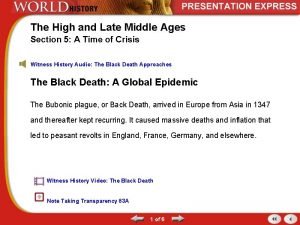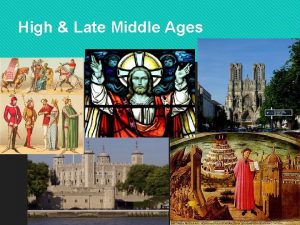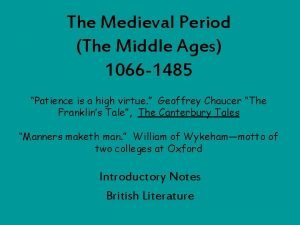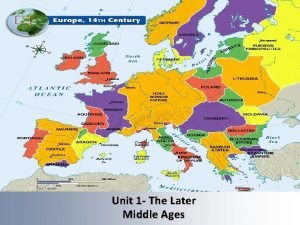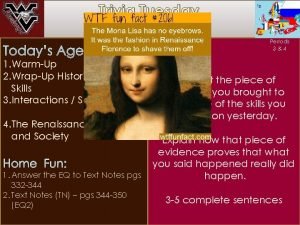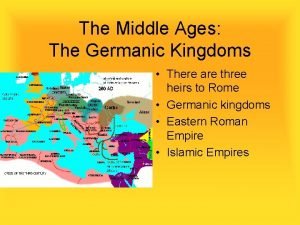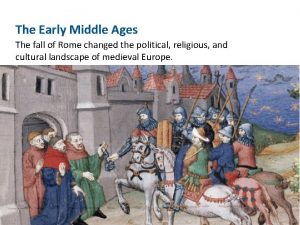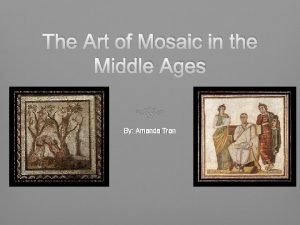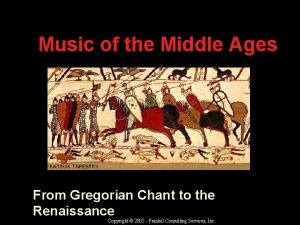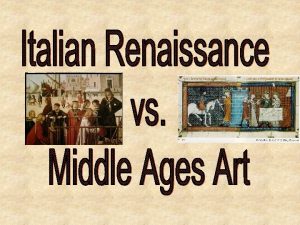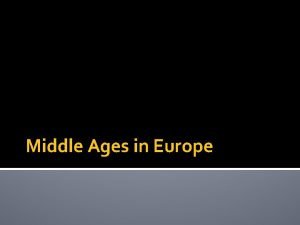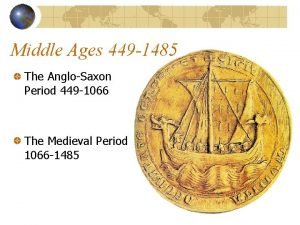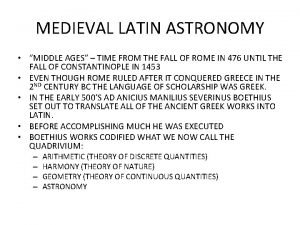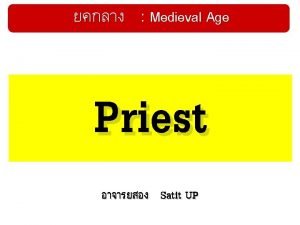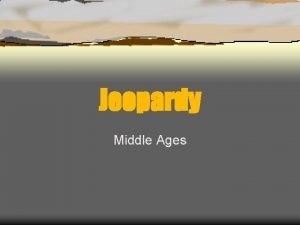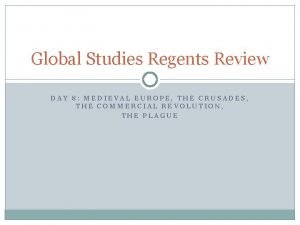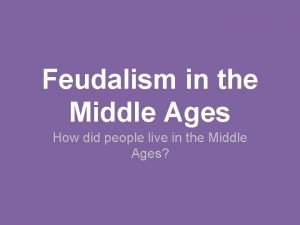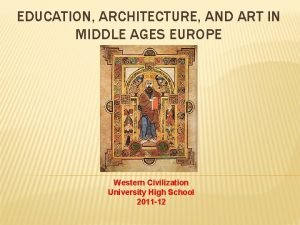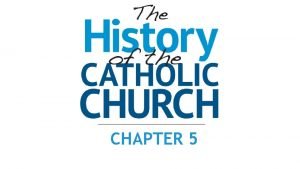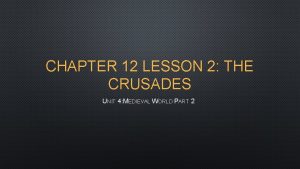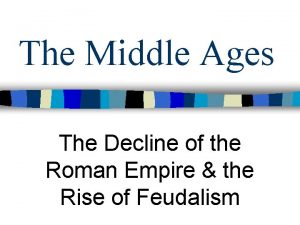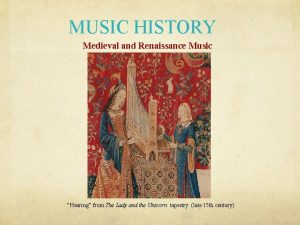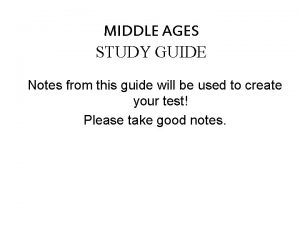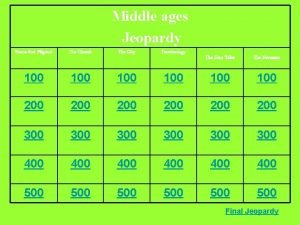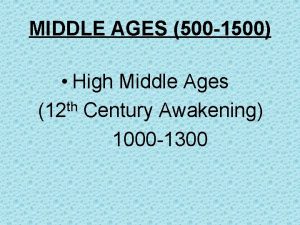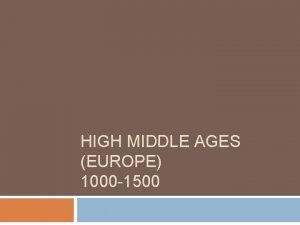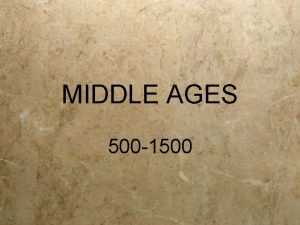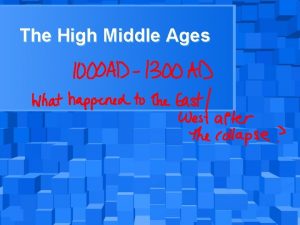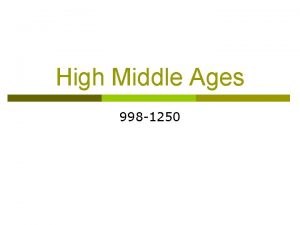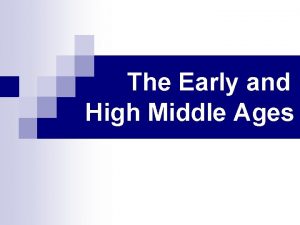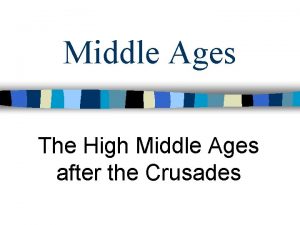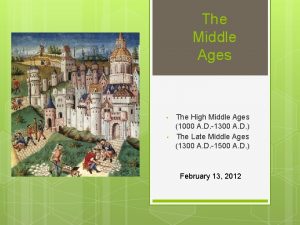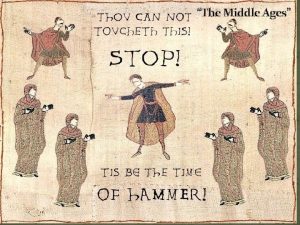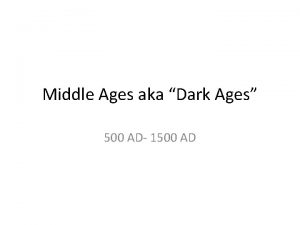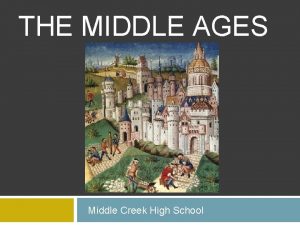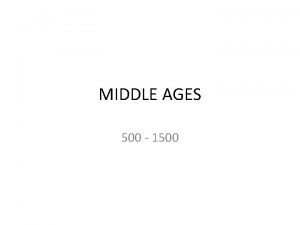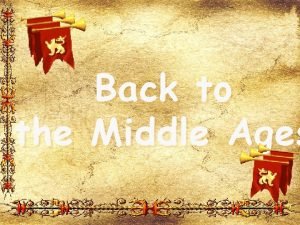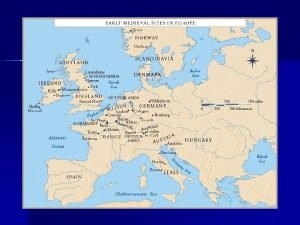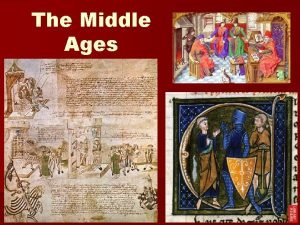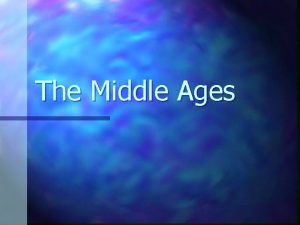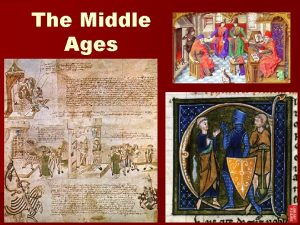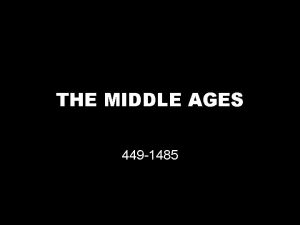800 1500 A D High Middle Ages 800































- Slides: 31

800 -1500 A. D.

High Middle Ages 800 1500 The Age of Faith Between 800 and 1100, churches were built in the Romanesque style. These churches had round arches and tiny windows set inside thick walls. Beginning in the 1100 s, a new style of architecture, Gothic evolved. They were tall cathedrals with large stained- glass windows.

The stained-glass windows illustrated stories from the Bible.

The Crusades were carried out by Christian political and religious leaders to take control of the Holy Land from the Muslims. Pope Urban II issued a call for a “holy war”, or commonly referred to as a Crusade.

He stated in his speech that Christians needed to regain the Holy Land, Jerusalem. He guaranteed those that fought in the Crusades were assured a place in heaven. Jerusalem was being attacked by the Seljuk Turks , who were Muslims. The Crusades had two goals: economic and religious motives.

1. The Crusades What is a crusade? a. i. ii. A holy war involving the journey of thousands of Europeans to reclaim the holy land of Jerusalem in the name of Christianity In all, there were 8 or 9 Crusades (depending on your source)

c. Why crusade? Social, Economic, Spiritual, & Political reasons i. Social: Opportunity to get knights to stop fighting each other and fight a new foe. These knights threatened peace in Europe. ii. Economic: The Holy Lands of Jerusalem were generally wealthier than Europe and many wanted to get their share of that wealth

c. Why crusade? Social, Economic, Spiritual, & Political reasons iii. iv. Economic: Younger sons who did not stand to inherit father’s property were looking for wealth and adventure Economic: Merchants supplied loans to finance the journey

Why crusade? Social, Economic, Spiritual, & Political reasons b. v. vi. Political: A chance for the pope to gain territory instead of Byzantine rival Spiritual: Fight/die on Crusade = ticket to heaven (Christian contradiction)

First and Second Crusades First Crusade (1097 A. D. )- Crusaders captured Jerusalem. Territory was gained from Edessa to Jerusalem. Those who died on Crusade were assured a Ticket to heaven. God wills it was the battle cry. 3000 mile journey from Europe to Jerusalem. i. Eventually, 12, 000 approached Jerusalem and besieged it for a month ii. On July 15, 1099, the Christians captured the city iii. In the process, the Christians slaughtered all of the Muslims left in the city

Four Crusader states were set up. Each ruled by a European noble. Second Crusade (1187 A. D. ) - Crusaders lost the Holy City of Jerusalem to the Muslim leader, Saladin.

Third and Fourth Crusades Third Crusade - Once again the Crusaders were defeated by Saladin and his men. Jerusalem remained under Muslim control. Fourth Crusade - Pope Innocent III demanded yet another attack on the Muslims. Instead the Crusaders looted Constantinople, capital of the Byzantine Empire in need of money to support their cause.

Spanish Crusade Ferdinand Isabella, Christian Monarchs, headed up a campaign, The Reconquista, to rid Spain of all Muslims. By the late 1490 s, the remaining Muslims converted to Christianity or left Spain is unified under the monarchs.

Effect of the Crusades Weakened the power of the Pope and Nobles, but strengthened the power of the monarchs. Stimulated trade throughout the Mediterranean area and the Middle East.

Left a legacy of bitterness among Christians, Jews, and Muslims. Weakened the Byzantine Empire Economic Effects of the Crusade Increased demand for Middle Eastern products. Stimulated production of goods to trade in Middle Eastern markets.

Trade promoted frequent contacts with the Byzantine and Muslim Empires. Encouraged the use of credit and banking. Letters of credit served to expand the supply of money and expedite trade. Church ruled against usury. Usury is the practice of lending money at a high interest rate.

• New accounting and bookkeeping practices by using Arabic numerals. Revival of Learning Muslims were more advance in many more areas than the Europeans. Crusaders brought back Muslim technology in the areas of ships, navigation, weapons, science and medicines, and mathematics.

European Scholars began writing in the vernacular, everyday language, instead of in Latin.

England France Develop ENGLAND William the Conqueror, leader of the Norman conquest, united most of England. Normandy is a region in the north of France that had been conquered by the Vikings.

William invaded England crowned himself king of England. Prior to his death nearly 200 Norman's held fiefs in England’s King, Henry II, a descendant of William owned land both in England France. He had two major goals: one, gain more territory from France and two, strengthen his power over the nobles and the church.

Common Law had it beginnings during Henry’s reign. Common Law is English Law that was the same for everyone. King John signed the Magna Carta, which limited the King’s power. The Magna Carta was set up to protect the barons rights as well at the rights to the townspeople and the church.

The Charter contained two basic ideas: 1. Nobles and English citizens had basic rights. 2. Monarchs had to obey the law. FRANCE • Hugh Capet established the French throne in Paris, and his dynasty gradually expanded their control over most of France.

Capetians ruled France for nearly 300 years. Phillip II was one of the most powerful Capetians. He was also known as Philip Augustus. Bubonic Plague The plague began in Asia and spread through most of Asia and the Muslim world.

By the mid 1300’s it had reached Europe. It first stop was Sicily and followed the trade routes from Italy, to France, Germany, and finally reached England. The disease became known as the Black Death.

Impact of the Black Death Population declined. A third of the European population was decimated. Labor was hard to come by. People were either dead or to ill to work. Towns were freed from feudal obligations.

The Church’s influence is on the decline. People lost faith when prayers did not help the ill. Many clergy left the area when the plagued infected the towns. Trade is disrupted. People are fearful or not allowed to trade with other towns.

The Hundred Years’ War The war was fought on French soil between England France. Joan of Arc, a French peasant girl, guided the French to victory. She was captured by the English and burned at the stake. Joan died as a martyr. A martyr is a person who dies for a cause they believe in.

Impact of the Hundred Years’ War The Hundred Years’ War helped to define France and England as nations. Brought a feeling of nationalism to both countries.

England experienced a period of internal turmoil. Two noble houses fought for the throne. The end of the war is considered the end of the Middle Ages.

� � England limited the powers of kings and increased the power of the nobility with A. the Codex Justinian. B. the Magna Carta. C. the English Constitution. D. the Civil Constitution. During the late medieval era, France had all of the following EXCEPT A. a tax on land salt. B. a professional army. C. a strong legislature. D. strong kings. The Black Plague first came to Europe through A. trade. B. exploration. C. the Church. D. the New World. The Hundred Years’ War was between which countries? A. France and Spain B. Russia and France C. England the Holy Roman Empire D. England France

� � The effects of the Crusades are all of the following except A. increased trade between Asia and Europe. B. decreased power of the nobility in many countries. C. increased tolerance and respect among religions. D. increased demand for Asian imports. In Spain, the movement to try heretics in church courts was called A. the Reconquista. B. the Inquisition. C. the “Spanish” policy D. the Papal Index. With the help of Ivan the Great, Russia was freed from the A. Mongols. B. Indians. C. French. D. Turks. Chronologically, which event came last? A. William of Normandy conquered England in the Battle of Hastings. B. The Black Plague struck for the first time. C. The fall of Constantinople to the Ottoman Turks D. The First Crusade
 Dark ages def
Dark ages def Dark ages vs middle ages
Dark ages vs middle ages The high and late middle ages section 5 quiz
The high and late middle ages section 5 quiz High to late middle ages
High to late middle ages High middle ages
High middle ages Middle english period 1066 to 1485
Middle english period 1066 to 1485 Map of europe in middle ages
Map of europe in middle ages Renaissance vs middle ages
Renaissance vs middle ages Germanic kingdoms in the middle ages
Germanic kingdoms in the middle ages French period floral design
French period floral design Early middle ages
Early middle ages Mosaic middle ages
Mosaic middle ages Late middle ages timeline
Late middle ages timeline Gregorian chant middle ages
Gregorian chant middle ages Renaissance vs middle ages
Renaissance vs middle ages Middle ages def
Middle ages def Middle ages description
Middle ages description Astronomy in the middle ages
Astronomy in the middle ages Church hierarchy
Church hierarchy Middle ages jeopardy
Middle ages jeopardy What were two indirect results of the crusades
What were two indirect results of the crusades Feudal system in the middle ages
Feudal system in the middle ages Education in middle ages
Education in middle ages What word means rebirth
What word means rebirth Similarities between middle ages and renaissance
Similarities between middle ages and renaissance Middle ages def
Middle ages def Chapter 12 lesson 2 world history
Chapter 12 lesson 2 world history Art in emerging europe summary
Art in emerging europe summary Middle ages
Middle ages Church modes
Church modes Middle ages study guide answer key
Middle ages study guide answer key Language answer
Language answer


